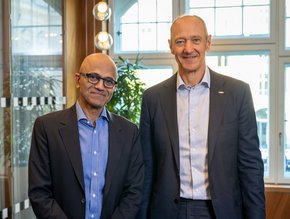5G: unlocking Europe’s competitive edge

Andrew Brown, General Manager, IBM Cloud & Cognitive Software Europe at IBM, discusses Europe's competitive edge when it comes to 5G.
The commercial potential of 5G is enormous, with estimates suggesting related technologies will contribute as much as $484 billion to the European economy over the next 14 years. But many businesses risk missing out due to a failure to understand and prepare for it properly.
When 4G began to roll-out, most organisations failed to anticipate the impact it would have. Over a decade later, some are still struggling to get to grips with the mobile-first implications and shift in consumer habits it prompted.
Today, the scope for disruption is exponentially larger. Where 3G and 4G were very much incremental advancements designed to increase speed, 5G is a revolutionary new approach with the power to reshape entire industries.
The most significant outcome of 5G's deployment for businesses is that it enables edge, a distributed computing framework that brings enterprise applications closer to the data sources they depend on. This might not sound all that exciting on paper, but analysts believe its impact will be so great that by 2022 more than half of enterprise-generated data will be created and processed at the edge, instead of in the datacenter or the cloud.
However, there are a number of issues that need to be addressed before edge computing can be implemented and European businesses can benefit, not least the need for enterprises to modernise their cloud strategies.
Not just another ‘G’
The first thing to establish is that 5G is not just faster 4G. Yes, 5G delivers massively improved speed and bandwidth. But it also boosts capacity, ensuring hundreds of thousands, if not millions more devices can access a network simultaneously without impacting performance. And it reduces latency, delays to the transmission of mobile data, to the very low milliseconds, or quicker than the blink of an eye.
These developments alone offer huge benefits for businesses. But things start to get really exciting when 5G converges with the worlds of IoT, AI and cloud.
The emergence of IoT has led to an explosion in the number of devices networks are required to support. Where traditionally the data generated is processed centrally via the cloud, often infused with AI to glean insights, it’s become clear that more of this computing needs to take place at source - otherwise known as the edge - to maintain and improve network performance.
The performance benefits provided by 5G make this possible, and will prove an essential part of the puzzle as more enterprises look to build edge into their cloud strategies. Where cloud will continue to serve as an aggregation point for some data and back-end functions, the edge will support real-time analytics where and when the data is created.
Crucially, edge is not just about the ability to analyse data at source, but taking action there too. This is where edge enablement can really deliver value, disrupting legacy process and unlocking new use cases to improve performance.
Early applications of edge computing in Europe
Europe's economy has long relied on its prowess as an industrial powerhouse. From manufacturing to biomedical development, the continent has an enviable track record in blending decades of expertise with cutting-edge technology to maintain its position as a global leader.
5G and edge represent the next frontier for industrial sectors.
One industry often held up as an example of where 5G and edge will have massive impact is the automotive sector. With connected cars already on the road, and highly autonomous vehicles around the corner, it won't be long before every vehicle on the road is considered an edge device. But we don't need to look that far into the future to see the kind of transformation edge might provoke, as forward-thinking automotive businesses are already using it to reinvent long-standing services. G-Evolution, for example, is transforming the auto insurance industry using a new telematics solution. Combining AI, IoT, 5G and hybrid cloud, the system reveals insights related to driving patterns and vehicle locations, increasing the accuracy of risk assessment and the effectiveness of claims management.
Perhaps the most commonly referenced example of edge-enabled disruption is the modernisation of manufacturing, otherwise known as Industry 4.0. This will see factories replace wired infrastructure with wireless connectivity like private 5G networks, seamlessly linking sensors, automated machines, autonomous robots and software to expedite more dynamic production capabilities. Applying analytics to the wealth of real-time data these factories generate enables new functionality, such as predictive maintenance. By helping organisations to foresee possible infrastructure failures, preventative action can then be taken, reducing downtime.
It's not just solutions to business problems that edge has the potential to transform. The technology is also being used to address some of the big issues we face as a global society. Advancing our understanding of ocean pollution and global warming, marine research organisation ProMare has built the Mayflower, an autonomous ship that will collect a wealth of data while it traverses the Atlantic Ocean. And edge technologies help manage a network of cameras, radar systems, and a weather instruments so the vessel can self-navigate as it goes about its important work.
Honing your competitive edge
For the majority of organisations, the use of edge computing demands business transformation.
Ask yourself the following questions. Does your current infrastructure allow analytics or IoT workloads to be securely deployed, remotely managed and automated via a single pane of glass? Will your systems be able to cope with real-time analysis of data generated by thousands of edge devices? If not, your organisation will need to make some changes to benefit from edge computing.
A hybrid multicloud strategy addresses these challenges head-on and is a key enabler of edge. Delivering the flexibility to support a more distributed computing approach, it enables the deployment of cognitive applications like AI at scale. Further, it provides the flexibility needed to bring together the edge with IT data centers, private clouds and public clouds from multiple providers.
This is why the use of open platforms based on open technologies like Linux and Kubernetes is also important. They allow businesses to deploy, run and manage data and applications on the cloud of their choice, without the risk on vendor lock-in. Positioning enterprises for benefits including faster innovation, access to a huge community of developers, and greater agility, open technologies are a major driver of competitive advantage.
Beyond preparing organisationally and technologically, enterprises will need to build a network of partners to help. Edge will be highly complex to deploy and require expertise in multiple fields. Given most critical applications will require private 5G networks to ensure resilience, close collaboration with a telecommunications partner throughout the planning and implementation phases will be particularly vital. Moreover, once deployed, any application or network management support will need to be compatible with open hybrid multicloud principles.
Seizing the opportunity
Europe by and large missed out on shaping the 4G revolution due to a mix of delayed deployments and enterprises being caught off guard at the incredible change wrought by the smartphone. We may still be in the early days of edge, but organisations cannot afford to be complacent and make the same mistake. A great deal of preparation is required to get ready for 5G integration, and there are already compelling use cases already driving business value across multiple sectors. There really is no time to waste.
SEE ALSO:
For more information on business topics in Europe, Middle East and Africa please take a look at the latest edition of Business Chief EMEA.






